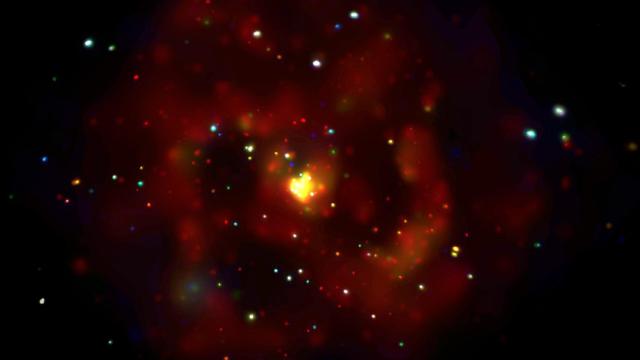After axions were first theorised by physicists in the suburbs of Chicago 45 years ago, they quickly became a robust candidate for explaining dark matter. All this time, though, the ultra-small particles have remained hypothetical. Now, a team of astrophysicists have proposed that axions may be responsible for an excess of X-ray emissions seen coming from a group of neutron stars in our galaxy.
The stars — dubbed the “Magnificent Seven” — are neutron stars that emit low-frequency X-ray radiation from their surfaces. Neutron stars are the extremely dense afterlives of collapsed stars. They possess powerful magnetic fields, and, as their name would suggest, are constituted in large part by neutrons. The new research, published this week in the journal Physical Review Letters, focuses on a yet-unexplained bunch of high-frequency X-rays that the seven stars are giving off.
“It’s possible that what we’re seeing here is evidence for new physics, is evidence for axions, which would transform our understanding of nature in a really huge way, which is hard to convey,” Benjamin Safdi, particle physicist at the Lawrence Berkeley National Laboratory and lead author of the recent paper, said in a phone call. “That discovery could come with this paper; it could come 500 years from now. That’s how science works, and so there’s no guarantee of instant gratification.”
[referenced id=”1100424″ url=”https://gizmodo.com.au/2018/04/if-tiny-dark-matter-particle-exists-this-experiment-is-now-ready-to-find-it/” thumb=”https://gizmodo.com.au/wp-content/uploads/2018/04/10/itoit15zksptui9xkdrq-300×169.jpg” title=”If Tiny Dark Matter Particle Exists, This Experiment Is Now Ready To Find It” excerpt=”Scientists are turning the tuning knob on an experiment that’s essentially a radio receiver inside of a magnet. It’s been around for years, but now it might finally be sensitive enough to hear a whole new kind of particle – one that could explain the mystery of the universe’s dark…”]
The main uncertainty about axions revolves around their existence. In other words, there is consensus among physicists about the properties these theoretical particles would possess, should they exist. One such property is that axions would interact very weakly, and rarely, with ordinary matter. Instead of scattering off the matter in the star, the axions would simply escape. Another is that axions can turn into photons in the presence of magnetic fields — like those surrounding the seven neutron stars.
The researchers compare the axions’ possible behaviour to neutrinos, a similarly small particle (albeit one whose existence is proven) that rarely interacts with other matter. Neutrons within neutron stars are known to collide and emit neutrinos, which is a primary way the star cools over time.
The team’s proposition is that axions could be created in the centres of neutron stars, where it is much hotter and more energised than the star’s surface. Just as neutrons inside that dense, super-hot region produce neutrinos through their collisions, so too could axions be produced. The difference is that in the presence of a magnetic field, the axion could convert into a photon. That photon’s fizzing energy would be detectable on the X-ray spectrum, specifically in the high-frequency range. Previous data had been collected of these high-frequency waves, but only as a byproduct of the main subject of inquiry: the low-frequency X-ray waves coming off the stars’ surfaces.
[referenced id=”1223892″ url=”https://gizmodo.com.au/2020/06/extremely-sensitive-dark-matter-experiment-detects-something-weird/” thumb=”https://gizmodo.com.au/wp-content/uploads/2020/06/18/jcj3o2ytee69wdcpqn29-300×168.jpg” title=”Extremely Sensitive Dark Matter Experiment Detects Something Weird” excerpt=”A mysterious signal has appeared in an extremely sensitive dark matter-hunting experiment. And after more than a year of trying to convince themselves that they were looking at noise, scientists think they might have found something new.”]
“We’re not claiming that we’ve made the discovery of the axion yet, but we’re saying that the extra X-ray photons can be explained by axions,” said Raymond Co, an astrophysicist at the University of Minnesota and a co-author of the paper, in a press release. “It is an exciting discovery of the excess in the X-ray photons, and it’s an exciting possibility that’s already consistent with our interpretation of axions.”
Safdi’s hope is that future attention can be paid to a nearby white dwarf, a degenerate star that’s less compact and with a much cooler surface temperature than a neutron star. Since the white dwarves don’t give off low-frequency X-rays from their surface, no X-ray telescope ever had much reason to be pointed at one.
“There really is nothing that should show up in any X-ray wavelength,” Safdi said. “If we do see a signal, we can be much more confident that what we’re seeing is from axions.”
